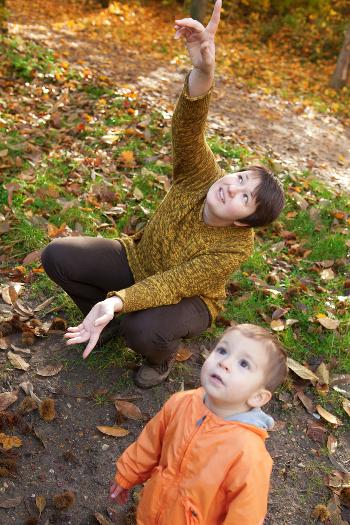Where did the sun go?
Duration/age

Next time you are outside with your child ask them what they can see in the sky. Is it different in the morning compared to late in the afternoon or evening?
There are lots of clouds up in the sky. Can you see anything else?
It is very hot today. What can you see in the sky that helps us to keep warm?
Talk to your child about what they can see. Is it always the same? Is the sun always in the sky?
It is nearly sunset. Look at the sun – it looks closer to the ocean and lower in the sky.
Explain to your child that the sun moves across the sky from east to west. The movement of the sun helps us to tell the time and to know when it is day time or night-time.
Materials you will need
- The sun
- Your eyes
Skills this activity improves
Why does this matter?
Children have a natural sense of wonder about the world around them. Stopping to talk about the things you notice in the sky or the natural environment helps children to make sense of what they observe. It also helps them to organise the information into meaningful patterns.
Talking together about where the sun goes helps your child to explore the concepts of time, night and day. As they notice changes to the position of the sun or the shadows growing on the ground they can group and compare the differences they see. As they talk about what they notice they are developing language to describe their thinking and observations. They will also be using language to describe time.
When children begin to describe their thinking they have started to hypothesise. When they hypothesise they are beginning to connect past experiences to what they see and to use this information to make decisions, reflecting on why things have happened.
What does this lead to?
Some children are naturally curious and creative, taking risks in their learning. Children who are naturally curious and creative often notice and wonder about what they see around them. They will ask questions and create their own answers. These children have a disposition to be creative and curious.
Talking about and exploring the natural and everyday environment with your child will help them to develop the skills to notice, take risks and ask questions. Even if your child does not have a natural disposition to be creative and curious, by exploring and posing questions you are helping your child to experiment with different ways of thinking.
Language to use
- Sun, moon, night, day
- Bedtime, sleep time, wake up time
- Morning, afternoon, night-time
- Shadow
- Movement, transition, direction
- East, west
- The sun sets, the sun rises
Questions to use
- Where does the sun go?
- Does the sun turn into the moon?
- Why does the moon change shape?
- Can the moon make shadows?
Useful tips
- You might also like to take a look at the activities Night-time creatures and Shadow play activity.
- If your child is between 3 and 6 years old, you might like the National Science and Technology Centre's activities and videos
- Young eyes are still growing and developing and they can be very sensitive to direct sunlight.
- Remember to talk to your child in your home language.
More ideas
Sort activities into what you do during the day and what you do at night.
Variation by age
Birth to two year olds
- Borrow stories from the library about night and day.
- Set the clock timer to ring when the sun is setting.
- See how many shadows you can find.
Three to five year olds
- Borrow stories from the library about night and day.
- Find the sunrise and sunset times in the paper.
- Google a world map. Try and work out where the sun is shining compared to the moon.
- Mark the different phases of the moon on a calendar.
Language to use
- Sun, moon, night, day
- Bedtime, sleep time, wake up time
- Morning, afternoon, night-time
- Shadow
Questions to ask
- Does the sun set at the same time every day?
- Do we ever see the sun and moon in the sky together?
- Do we all see the same sun?
- Does the sun swim in the ocean?
Language to use
- Sun, moon, night, day
- Bedtime, sleep time, wake up time
- Morning, afternoon, night-time
- Shadow
- Movement, transition, direction
- East, west


